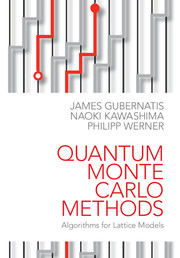Book contents
- Frontmatter
- Contents
- Preface
- Part I Monte Carlo basics
- Part II Finite temperature
- Part III Zero temperature
- Part IV Other topics
- 12 Analytic continuation
- 13 Parallelization
- Appendix A Alias method
- Appendix B Rejection method
- Appendix C Extended-ensemble methods
- Appendix D Loop/cluster algorithms: SU(N) model
- Appendix E Long-range interactions
- Appendix F Thouless's theorem
- Appendix G Hubbard-Stratonovich transformations
- Appendix H Multi-electron propagator
- Appendix I Zero temperature determinant method
- Appendix J Anderson impurity model: chain representation
- Appendix K Anderson impurity model: action formulation
- Appendix L Continuous-time auxiliary-field algorithm
- Appendix M Continuous-time determinant algorithm
- Appendix N Correlated sampling
- Appendix O The Bryan algorithm
- References
- Index
12 - Analytic continuation
from Part IV - Other topics
Published online by Cambridge University Press: 05 May 2016
- Frontmatter
- Contents
- Preface
- Part I Monte Carlo basics
- Part II Finite temperature
- Part III Zero temperature
- Part IV Other topics
- 12 Analytic continuation
- 13 Parallelization
- Appendix A Alias method
- Appendix B Rejection method
- Appendix C Extended-ensemble methods
- Appendix D Loop/cluster algorithms: SU(N) model
- Appendix E Long-range interactions
- Appendix F Thouless's theorem
- Appendix G Hubbard-Stratonovich transformations
- Appendix H Multi-electron propagator
- Appendix I Zero temperature determinant method
- Appendix J Anderson impurity model: chain representation
- Appendix K Anderson impurity model: action formulation
- Appendix L Continuous-time auxiliary-field algorithm
- Appendix M Continuous-time determinant algorithm
- Appendix N Correlated sampling
- Appendix O The Bryan algorithm
- References
- Index
Summary
The presence of dynamical information is a feature distinguishing a finite-temperature quantum Monte Carlo simulation from a classical one. We now discuss numerical methods for extracting this information that use techniques and concepts borrowed from an area of probability theory called Bayesian statistical inference. The use of these techniques and concepts provided a solution to the very difficult problem of analytically continuing imaginary-time Green's functions, estimated by a quantum Monte Carlo simulation, to the real-time axis. Baym and Mermin (1961) proved that a unique mapping between these functions exists. However, executing this mapping numerically, with a simulation's incomplete and noisy data, transforms the problem into one without a unique solution and thus into a problem of finding a “best” solution according to some reasonable criterion. Instead of executing the analytic continuation between imaginary- and real-time Green's functions, thereby obtaining real-time dynamics, we instead estimate the experimentally relevant spectral density function these Green's functions share. We present three “best” solutions and emphasize that making the simulation data consistent with the assumptions of the numerical approach is a key step toward finding any of these best solutions.
Preliminary comments
The title of this chapter, “Analytic Continuation,” is unusual in the sense that it describes the task we wish to accomplish instead of the method we use to accomplish it. If we used the name of the method, the title would be something like “Bayesian Statistical Inference Using an Entropic Prior.” A shorter title would be “The Maximum Entropy Method.”We hope by the end of the chapter the reader will agree that using the short title is perhaps too glib and the longer one has meaningful content.
- Type
- Chapter
- Information
- Quantum Monte Carlo MethodsAlgorithms for Lattice Models, pp. 367 - 397Publisher: Cambridge University PressPrint publication year: 2016

